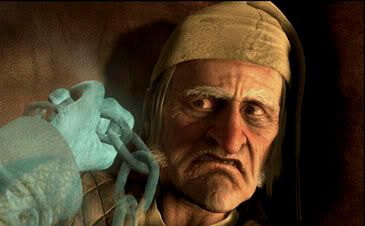

Robert Zemeckis has done this once before. As he did with "The Polar Express," using his photo-realistic, motion-capture animation technique, he has adapted a holiday story for not just the big screen, but the really big screen: IMAX. And this time, 3-D. Much like he proved with the surprisingly adept "Beowulf," Zemeckis certainly knows how to put 3-D to good use. The thing with his "A Christmas Carol," corporately labeled as a Disney production, is that the animation is better, and yes, the 3-D is wondrous. The look of real actors being animated comes off much less creepy here than it did in "The Polar Express," but even so, that was a better film. The issue is that this time Zemeckis is adapting the timeless 1838 story by Charles Dickens. All the trimmings of Victorian yuletide cheer are there, but the emotional feeling of being a classic just isn't.
This is a premise we all know, so it's not worth repeating, but here's a basic outline: Ebenezer Scrooge (Jim Carrey) is a bitter old man whose business partner, Jacob Marley (Gary Oldman), died on Christmas Eve. He therefore hates Christmas, and with his stooped back, drooping skin, and pale eyes, he loathes everything about the holiday. He is visited by the Ghosts of Christmas Past, Present, and Future, all distinct and all teaching Scrooge things about himself he may have never even realized before. Majority of the dialogue throughout the film is directly lifted from the original story, and to that extent this adaptation pays rightful tribute to Dickens. Zemeckis stays true to Dickens' most potent and finest themes, and with such comes a rather dark tone, one that focuses on moral disparity and even death. In this instance the movie can be eerie and even downright scary, which means that this is one definitely not for the youngest kids.
There's no denying that Zemeckis' "A Christmas Carol" is visually splendid with sequences swirling with magic and a rendering of 19th century London that is seamless and gorgeous. And yet it feels like Zemeckis gets a little carried away. This isn't meant to be the Christmas Carol roller coaster ride, and perhaps there simply wasn't enough material to work with. Between all of the exuberantly-designed chase and action sequences, the real narrative, the appearance of each ghost, almost become the backdrop to the thrill-ride. It gets tiring after a while, especially when there is so much to offer with Zemeckis' vision of these ghosts. The Ghost of Christmas Past is exceptional with just a face in a lit candle, whispering and flickering.
Jim Carrey pulls his weight, voicing not only Scrooge but also the three ghosts. Gary Oldman does the voices of Bob Cratchit, Tiny Tim, and Marley. Deep beneath the layers of animation is Carrey playing Scrooge quite well as he does a good job of playing it straight without any flairs or goofiness. The expressions of the CGI characters are now more fully-realized with thanks to technological advancements. Scrooge is no caricature with Carrey giving him the perfect dose of remorse and melancholy.
While Zemeckis works hard to stick with Dickens' sentiments, one must really wonder at the end of viewing "A Christmas Carol" if another adaptation was really necessary. It's a sight to behold and certainly will get viewers promptly in the mood for the holiday season (which perhaps is the primary goal), but the desired emotional level of connection is never reached. The plight of Tiny Tim is there in all of its sadness, but I just didn't find myself in sympathy as much as I felt I should've. Observing Scrooge's personal transformation becomes like viewing it from afar, and the endeavor feels ultimately removed and sadly soulless.





No comments:
Post a Comment